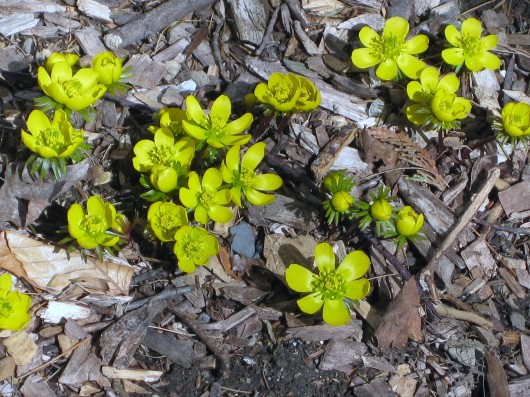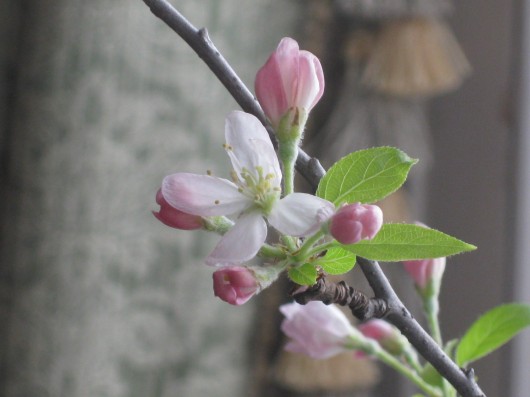Last updated on February 28th, 2013
 SOUND FAMILIAR? In March, the winter aconites (above) typically emerge in Monday’s warmth, and then disappear in Tuesday’s snow. Consequently it pays to make haste slowly these final weeks of winter. Here are the month’s chores, based on my zone 5-b, Hudson Valley, NY location:
SOUND FAMILIAR? In March, the winter aconites (above) typically emerge in Monday’s warmth, and then disappear in Tuesday’s snow. Consequently it pays to make haste slowly these final weeks of winter. Here are the month’s chores, based on my zone 5-b, Hudson Valley, NY location:
Winter-Sowing. Continue to sow perennials and hardy annuals (including spinach) in make-shift greenhouses. Wait until late this month or early next to sow tender annuals and vegetables.
Raised Beds. You won’t have to buy new soil for these if you top them off with shredded leaves. Give the leaves a light sprinkling of alfalfa meal, cottonseed-meal, or another organic source of nitrogen to help hasten their decay.
Lawns. When the ground is dry enough not to damage grass, rake up the accumulation of twigs and branches.
Arborvitae. If heavy, wet snow (such as fell here this week) has flattened branches, lash them back into place with twine. Stems should regain their upright habit over the course of spring and summer. My guide to repairing snow-damaged, multi-leadered arborvitae.
Roses. Wait until the end of the month to uncover bushes; prune them at your convenience but before the leaf buds break. Don’t try to prepare new beds until the ground is well thawed and the soil is workable.
Pruning. Definitely relieve trees and shrubs of dead wood. Also, prune for shapeliness Peegee hydrangeas, Rose of Sharon, and any other shrubs that bloom in late summer. Cut Buddlejah back to ground-level, unless you want a monster-size shrub.
Iris. Examine these and other perennials for signs of heaving. Especially if your garden has not been mulched, you will need to go over plantings and firm back roots dislodged by frost.
 Spring-Flowering Trees & Shrubs. Any time now you can cut stems of forsythia, pussy willow and crab apple. Give the stems water, light, and warmth, and they will bloom for you in only two weeks’ time. My detailed list of what to force, and when.
Spring-Flowering Trees & Shrubs. Any time now you can cut stems of forsythia, pussy willow and crab apple. Give the stems water, light, and warmth, and they will bloom for you in only two weeks’ time. My detailed list of what to force, and when.
Houseplants. Due to lengthening hours of daylight, these are growing rapidly now. Reward them with extra food and water. My collection of indoor plants, and how I care for them.
Tulips, etc. Continue to water and fertilize these hardy forced bulbs after their flowers fade. Once the foliage withers, withhold all moisture. Then store the bulbs someplace cool and dry. In autumn, give them permanent positions in the outdoor garden. Bulbs I’ve successfully forced for winter-bloom.
Lily of the Valley. Ask your florist now for cold-storage forcing pips. In twenty-one days they will bring a sweet-sweet fragrance to your rooms.
Go to a Show! Want to find good-sized plants at bargain prices? Visit your local garden-show. This year, New York’s Capital District Flower & Garden Show is March 23-25. On the final show-day, exhibiting landscapers usually offer beautiful, in-bloom rhododendrons, lilacs, and other flowering shrubs as well as evergreens for a fraction of the retail price. Why? Because they obtained these plants purely for design purposes. They have little interest in keeping them once showtime is over. The rhododendrons in my Woodland Garden were all acquired (for a song) this way.
Don’t miss anything at A Garden for the House…sign up for Kevin’s weekly newsletter.
Related Posts:
Make Your Own English Muffins
My Easy-to-Maintain Kitchen Garden
Over-wintered Plants: What to Do Now

Patricia Sterling says
In NC I had an irIs (blue) that had a wonderful fragrance-do you know the name-they almost glowed in the dark at twilight
Kevin Lee Jacobs says
Patricia – Maybe ‘Blue Fire’? It is a pale blue iris with a pleasantly strong, sweet scent.
Beverly says
This weekend I have been doing a lot of iris research online as I am trying to identify an antique bitone Iris I have had for decades. I also grow the classic blue Iris pallida, dating to 1789, known for its grape Koolaid fragrance. Perhaps this is the fragrant iris Patricia mentioned. Here’s a link to the Historical Iris Preservation Society which has wonderful photos, alphabetized, plus a lot of other pertinent information.
http://www.hips-roots.com/visitors/v-photos/vp-topframe.html
http://www.oldhousegardens.com/display.aspx?cat=iris&page=2
This link dates Iris pallida to 1597 !
I am captivated by the histories of these individual Iris varieties.
Lex Malla Books says
We are new to gardening and just starting ours. It has been fun to read your post because we really have NO idea what to do.
lexmallabooks.com